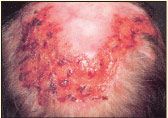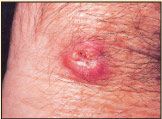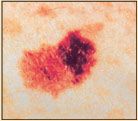What Is Your Skin Cancer IQ?
May is National Skin Cancer Awareness MonthWhat Is Your Skin Cancer IQ?Identifying BCC, SCC, and melanoma
Basal Cell Carcinoma (BCC)
Squamous Cell Carcinoma (SCC)
Melanoma



Appearance
Small, shiny bumps or nodules that are red, pink, or white; persistent, nonhealing sore; reddish flat patch; or a scar-like white or yellowish area
Red, scaly patches or bumps
Asymmetrical, mottled patches with notched or blurred borders, typically in tan, brown, or black
Size
Takes many years or months to reach a half-inch
Can reach up to three-quarters of an inch to an inch
Usually greater than 6 mm
Location
Head, neck, hands, and occasionally on the trunk of the body
Face, ears, neck, lips, and back of the hands
Can occur anywhere on the body, most frequently on the upper back or legs, as well as the head and neck
Progression
Grows slowly and may bleed, crust over, then the cycle repeats
Can develop into large masses
Can appear without warning, or may begin in or near a mole or other dark spot on the skin
Potential for metastasis
Rare, but can grow into nearby areas and may invade bone and vital structures, such as the eye
Can metastasize, and may be fatal if not treated
Can metastasize, and is deadly if not treated
Prevalence
BCC accounts for 80% of all skin cancers (more than 800,000 new cases each year).
SCC accounts for 16% of all skin cancers (approximately 250,000 new cases each year). About 2,500 deaths from SCC are expected during 2007.
Melanoma accounts for 4% of all skin cancers (approximately 59,940 new cases each year). More than 8,110 melanoma deaths are expected during 2007.
Adapted, with permission, from the American Academy of Dermatology’s “Actinic Keratoses and Skin Cancer,” available at http://www.aad.org/public/News/DermInfo/DInfoSkinCancerUpdates.htm.
Articles in this issue
Further Perspectives on Inflammatory Breast Cancer
FDA Accepts Satraplatin NDA and Grants Priority Review
The Unfolding Story of Imatinib Mesylate for Chronic Myeloid Leukemia
Erlotinib Extends Life of Patients With Pancreatic Cancer
Inflammatory Breast Cancer: Still Poorly Characterized
Treatment of Localized Soft-Tissue Sarcoma: Lessons Learned
Chronic Phase Chronic Myeloid Leukemia: More Drugs, More Lives Saved, New Challenges
New Insights, Future Directions in Primary Cutaneous Lymphoproliferative Disorders
Quality of Cancer Care Measures for Breast and Colorectal Cancer Jointly Released
Data Available From Cetuximab Study in First-Line Treatment of Advanced Pancreatic Cancer
Adjuvant Therapy for Pancreatic Cancer: No 'Definite' Standard
Today's Forecast for the Adjuvant Treatment of Pancreatic Cancer: Clear or Cloudy?
What Is Your Skin Cancer IQ?
Optimal First-Line Treatment of Chronic Myeloid Leukemia: How to Use Imatinib and What Role for Newer Drugs?
Adjuvant Therapy for Pancreatic Cancer: To Treat or Not To Treat?
Related Content